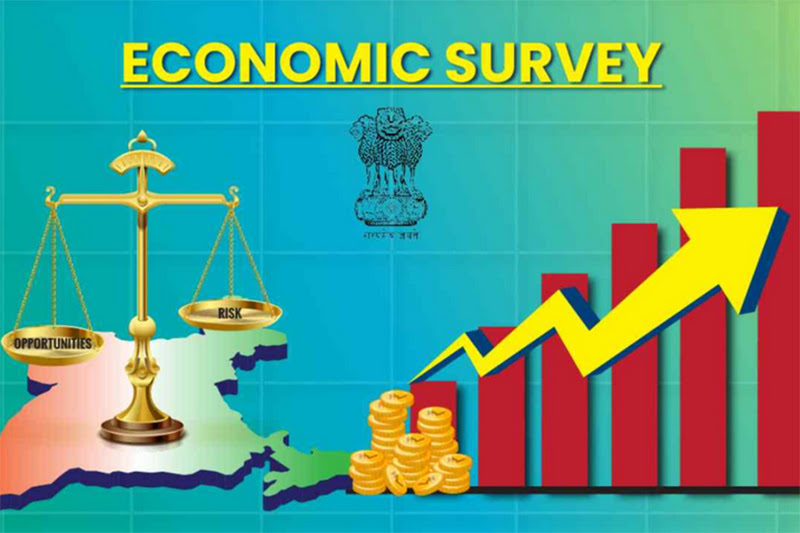The Economic Survey report, which examines the economic performance of the previous year and projects the outlook for the upcoming year, was compiled by the Department of Economic Affairs’ Economics Division under the direction of the Chief Economic Advisor. Key metrics like GDP, inflation, employment, and trade are all covered in this comprehensive assessment of the Indian economy’s current state.
Economic Survey 2024
Notwithstanding, beginning around 1964, it has been given independently, guaranteeing zeroed in consideration on the far reaching economic audit and its suggestions. On July 22, 2024, immediately following the President’s Address, Union Finance Minister Nirmala Sitharaman presented the Economic Survey for the Financial Year 2023-2014. The Indian economy’s performance over the past year was detailed in this comprehensive document, as were future prospects, obstacles, and policy recommendations.
Read More:-
About Economic Survey
The first Economic Survey was published, and it was presented in 1950-51 alongside the Union Budget for the first time. However, since 1964, it has been administered independently, ensuring that the extensive economic audit and its recommendations are fully taken into account. The Economic Survey for the Financial Year 2023-2014 was presented by Union Finance Minister Nirmala Sitharaman on July 22, 2024, immediately following the President’s Address. This comprehensive document detailed the performance of the Indian economy over the past year, as well as future prospects, challenges, and policy recommendations.
Economic Survey Key Features
Resilient Economy: The Indian economy kept up with vigorous development, surpassing 7% for the third back to back year. Stable consumption patterns and rising investment demand fueled this expansion.
Improved Current Account Deficit: India’s Current Account Deficit (CAD) decreased from 2.0% of GDP in FY23 to 0.7% of GDP in FY24, indicating a stronger balance of payments.
Robust Forex Reserves: India’s foreign exchange reserves were substantial as of March 2024, covering more than ten months’ worth of anticipated imports and 98 percent of its external debt, ensuring financial stability.
Stable Banking Sector: The banking industry performed well, with double-digit credit growth, low Non-Performing Assets (NPAs), and improved asset quality indicating a financial system that is stable and resilient.
Core Inflation Falls: Retail inflation was kept at 5.4% in FY24, the lowest level since the pandemic, thanks to effective management. The Reserve Bank of India (RBI) achieved this through strategic policy interventions and measures.
India’s Challenging Global Environment
The resilience of the Indian economy in the face of geopolitical challenges can be seen in its strong and steady foundation. The recovery that followed Covid has consolidated, and policymakers have ensured economic and financial stability. In any case, supporting recuperation requires critical endeavors on the homegrown front because of the difficult worldwide climate on issues like exchange, speculation, and environment. For FY25, the Economic Survey anticipates real GDP growth of 6.5-7%. Domestic growth drivers have supported economic growth in FY24 despite global economic uncertainty. A normal rainfall forecast, improved private sector balance sheets, and strong investment demand are likely to boost agriculture performance and rural demand.
Read More:-
Bravest Freedom Fighters of India
India’s Inflation Trend
Administrative and monetary policies have been used to control inflationary pressures brought on by global issues, disruptions in supply chains, and variations in monsoon conditions. From 6.7% in FY23, retail inflation decreased to 5.4% in FY24. Core inflation in both goods and services decreased in tandem with this decrease. Food inflation was 7.5% in FY24, despite difficulties in the agricultural sector. Inflation is expected to drop to 4.5% in FY25 and 4.1% in FY26, according to the RBI’s projections. The monetary equilibrium of the overall government has improved in spite of expansionary public speculation. Procedural changes, use restriction, and expanding digitization have added to this equilibrium.
Education & Skill Development
India is moving forward with a new welfare system that places an emphasis on empowerment, universal access to necessities, and increased participation from the private sector. The education sector is being transformed by the NEP 2020, and Ayushman Bharat is significantly lowering the out-of-pocket costs for poor families’ healthcare.
Step-by-Step Get PDF of Economic Survey 2024 PDF
- Open a web browser and type https://www.indiabudget.gov.in/economicsurvey/ into the address bar to access the official Economic Survey page.
- You will find the section devoted to the Economic Survey once the page loads. The most recent edition is typically pominently displayed in this section.
- The Economic Survey is coming in 2024. The most recent survey is typically added to the webpage as soon as it is made available. To access the document, a button or link will be provided.
- Select the link labeled “Economic Survey 2024 PDF” or something similar. The PDF file should now appear in your web browser after this.
- You can download the PDF by clicking the download icon, which is typically located in the PDF viewer’s upper right corner once the file opens. Alternately, you can save the document to the desired location on your device by right-clicking on it and selecting “Save As.”
Read More:-
Final Words
Strategic administrative and monetary policies effectively managed inflationary pressures caused by global factors, supply chain disruptions, and erratic monsoons, according to the Survey. Retail inflation, which had been 6.7% on average in FY23, fell to 5.4% in FY24 as a result. Retail inflation was successfully kept at 5.4% in FY24, the lowest level since the pandemic, thanks to timely government interventions and the Reserve Bank of India’s price stability measures, according to the report.
